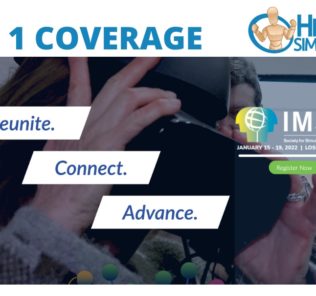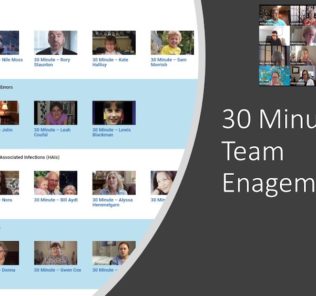GNSH Shares Stories About Medical Errors to Improve Patient Safety
The third week of the 2021 International Meeting for Simulation In Healthcare (IMSH) featured a session titled “What Will It Take to Improve Patient Safety” by the leadership of The Global Network for Simulation in Healthcare (GNSH). The session started with the sad reminder about the recent sudden passing of Dr. Chad Epps, who was President of the organization which focuses on increasing the utilization of simulation to improve patient safety outcomes. Dr. Epps originally created and prepared the slides for this IMSH live presentation that emphasizes the importance of sharing real patient error stories to bring about awareness of patient safety issues. Here, Dr. Kim Baily recaps the session:
If the purpose of healthcare is to reduce errors and improve patient safety, there must be regular and frequent conversations amongst clinicians about safety issues. Clinicians are often so busy taking care of patients that finding time to participate in sessions aimed at identifying and preventing patient errors becomes difficult. Healthcare simulation, though helpful, may prove too time consuming and/or costly to run large numbers of personnel through this type of experience.
GNSH came up with the idea of stimulating discussions about patient safety by telling true stories of patient errors. Sessions would be held weekly and run for no longer than 30 minutes. The goals were to create a safe learning space using a high-frequency, low-dose model, learn from real stories and strengthen team communication and collaboration.
Sponsored Content:
Each 30-minute session is divided into several sections with the following suggested areas of discussion:
- Patient Story Part I: Introduce the goal of the activity. Current story content includes sepsis, medication errors, hospital associated infections and care teams.
- Team Engagement: Build an emotional link to the story.
- Patient Story Part II: Reveal the outcome of the case and the emotional implications for staff.
- Team Discussion: Reflect on future patient care.
- Systems Discussion: Ask what system changes need to be made and how they might be affected.
A short excerpt within this IMSH presentation showed parents talking about their little boy that died from sepsis. This served as an example of how participants could connect emotionally to a story. As demonstrated, failure to correctly diagnose sepsis and long wait times to obtain care likely contributed to the child’s death.
A second example was the story of an institution where “name and blame” was the first response but where further consideration helped change the culture of the institution. The story involves a nurse who had given insulin to a patient who was hypoglycemic even though the glucometer flashed a warning that the blood sugar was high. The patient also reported that she felt the same as when she had hyperglycemia.
The test was repeated several times, and on each occasion, the glucometer showed a high blood sugar warning. Other nurses made similar errors. The nurse gave insulin. Initially the nurse was disciplined and held accountable. However, a human factors research term reviewed the incident and found fault with glucometer and not the nurse.
Sponsored Content:
The true low reading was hidden on the small screen by a warning of a dangerously high dose. The hospital administration completely reversed their disciplinary action. The nurse shared her feelings about the incident, her response to being disciplined and her anguish over what had happened. The story created some lively comments from attendees and was clearly a useful vehicle for discussion of human factors and system failures as a cause of errors.
GNSH estimates that for a 250 bed hospital, weekly team training could result in 4,000 hours of instruction related to patient safety, 8,000 hours on process improvement and 26,000 hours of team building. However, then came the COVID-19 pandemic. Unfortunately, hospital pilot launches have been delayed until after healthcare facilities are not overwhelmed by caring for COVID patients. Academia, however, has started using these stories for nursing education.
There are currently 15 stories listed on the GNSH website with suggestions for stimulating discussions during and after the stories. Note, all stories and materials are free, although GNSH asks users to complete surveys and provide feedback about where and how they used the stories and how beneficial the stories were. GNSH is looking for more stories to turn into training sessions, particularly experiences related to pediatrics. The global network shared that managers, risk management departments and safety committees are often good sources of stories. If you know of any, please follow up on the GNSH website.
More About GNSH
The Global Network for Simulation in Healthcare envisions a healthcare culture that empowers people and systems to maximize safety outcomes for patients and staff. The mission of the GNSH is to advance healthcare training through modern approaches and innovative solutions.
The organization was formed after Aug. 4, 2010, when 27 individuals representing 16 regional, national and international organizations (with a substantive focus on healthcare simulation) attended an international simulation leadership summit at London Deanery, UK. The meeting was intended to empower the global simulation community to act collectively as clinical simulation continues to expand exponentially. The summit resulted in agreement by the representatives to form the global network for simulation in healthcare.
Today, the GNSH remains dedicated to spreading the message that healthcare simulation drives improvement, saves lives and can be done cost effectively. In addition to an annual summit, the GNSH spreads this message through 30-minute team engagement structured patient care stories and a toolkit to help make the case for clinical simulation to decision makers.
Learn More About GNSH
Dr. Kim Baily, MSN, PhD, RN, CNE has had a passion for healthcare simulation since she pulled her first sim man out of the closet and into the light in 2002. She has been a full-time educator and director of nursing and was responsible for building and implementing two nursing simulation programs at El Camino College and Pasadena City College in Southern California. Dr. Baily is a member of both INACSL and SSH. She serves as a consultant for emerging clinical simulation programs and has previously chaired Southern California Simulation Collaborative, which supports healthcare professionals working in healthcare simulation in both hospitals and academic institutions throughout Southern California. Dr. Baily has taught a variety of nursing and medical simulation-related courses in a variety of forums, such as on-site simulation in healthcare debriefing workshops and online courses. Since retiring from full time teaching, she has written over 100 healthcare simulation educational articles for HealthySimulation.com while traveling around the country via her RV out of California.
Sponsored Content:




















